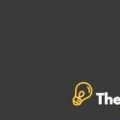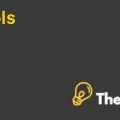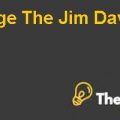Centralization of the Administrative Services (HR & Finance) Case Study Solution
Introduction
Centralization is processed by which the organization’s top level management has authority to take decisions on all subjects, problems, and matters that are being faced by the organization. That means that all actions are subjected to the approval of top management. So, centralization can be a process by which an organization takes control of all decisions, whereas the managers or the middle management is supposed to implement these decisions made by the top management.(Management Study Guide, 2016)
The application of centralization in the organization is against the decentralization system. Both structures have own complications within the structure and benefits, and disadvantages as well. But, it is important to know that how could centralization structure applied, and implemented to help the organization regarding controlled decision-making process and implementation of that decision by the middle management.
Moreover, the middle management might have concerns and reservations over the centralization structure, whereas they are not directly linked to decision-making because they are directed by the top management to implement their decisions. However, referring to our project about the centralization of administrative services HR and finance the question arises as to what organization structure should be incorporated with the centralization process.
The centralization structure is supposed to be built on the project deliverables and timeline of the implementing the centralization system in the organization from a de centralized system that gives decision-making authority to the middle management of the organizations to take decisions on their own and implement them.Furthermore, how a change in administrative services departments should be structured, that could benefit the organization.
Scope of Centralization
Human Resources Management
Human resources management departments are strategic partners of the organization, that they not only hire the candidates for a company that would drive the company towards achieving the organizational goals, and objectives. Similarly, the centralization of the HR services would be a better step that would provide strategic business advantages to the organization.
A centralized HR structure would save the cost and time of recruitment and selection process within the organization. The reason is that it would be better rather than the decentralized HR structure, where each manager belonging to the different department is responsible for recruiting and selecting the workers, and employees of his department, following the centralized HR system.
The HR department would become responsible for managing all HR related problems including recruitment, selection, payroll management, and better control over the operations provides efficiency in the work, and brings benefits for the company. In addition, the engagement of the HR employees with different department managers, supervisors, and employees would also enhance their quality of services being provided to them, which also reduce the processing time as well.
The knowledge sharing in the centralized system would also optimize the processes and the reason for that is because the core HR department can easily communicate the employee’s job descriptions, corporate goals, mission, visions, and objectives, and most important the characteristics of quality of the candidates.Moreover, a centralized human resource department can rapidly optimize the business processes so that HR department can easily, develop and coordinate the consistent processes for the recruitment and selection, performance management and recognition and payroll and benefits as well.
In centralized HR functions, it becomes very easy to communicate all these information throughout the company, and all procedures and process improvements are communicated company-wide. This all is controlled and communicated from within the one department rather than from various offices, and locations. However, the centralization of the HR could also benefit the organization in long term rather than shorter-terms.
A potential candidate selected through a proper process of the HR department would be more efficient than the employee selected through the respective department’s manager.It would also be of concern that employee selected through the proper channel would be selected over the long term with strategic goals. The HR department would also provide the training and development of the employees, so that they could fit in the organization’s goals and objectives more appropriately.
Finance Department Centralization
However, the Finance Department is responsible for planning and budgeting and implementing all lines being given by the organization’s top management level .The department that controls money is the finance department. The department is known for planning, budgeting, organizing, auditing, accounting and for controlling of the company’s finances. However, identifying potential benefits of centralization of the finance department is critical to understand.
Moreover, the finance department is manages, and controls money because the internal control for an organization is crucial before leakage of money. So, the internal control refers to the controlling the leakage of money in the organization. The money could only be traced and controlled if the company knows what its cash inflows are, and what its cash outflows in the organization, similarly, where and how money was expensed.
Similarly, when the company comes to know what are their inflows, and outflows, then it helps to overcome the problems being experienced by the company as a whole. Therefore, the centralized system would collect all the finance information form the company that would include the book building, and record keeping, and planning budgets, and implementing the budget as well. Similarly, there would be check and balance in the department.
The centralization of the finance department would also save the costs, enable the company to manage its finances more effectively from one place rather than from different departments independently, which incur extra costs, no check and balance or cross check, and no proper documentation. However, the increasing complexities in the accounting and finances would also be dealt effectively so that the organization grows towards its vision and mission.
Moreover, the implementation of the centralization process includes a collection of information about the company’s inflows and outflows because the department has to collect the information what departments have expenses, what the company is earning. Similarly, when department has collected all information about the company’s inflows, and outflows then the implementation of the book building and recording keeping could be executed. Furthermore, the planning and budgeting would be the next step into implementation along with the monitoring of the system.
In addition, the implementation of the centralized administrative services of the finance department is sensitive to implement, because, the finance department is the backbone of the organization regarding managing the wealth of company, which could give competitive advantages over the competitors in the market. It would also help the organization to cut unnecessary costs.
Work Break down Structure
The project would have time duration of 120 days to implement the centralized system in the organization. Similarly, two departments need to be centralized one; Finance and second is HR. However, both have their structure and possible steps. Therefore, in order to get an overview of a sample work breakdown in the both departments that give an overview of possible steps in the planning process. The project management has milestones, and phases from initial to the implementation.
The project goes through various stages until implementation. Similarly, our work breakdown structure also has multiple steps in the company.Therefore, in order to get an overview of those steps take a look in appendices at the taken snapshots of the work breakdown structure along with the milestones, and project duration as well, our project has the initial four phases.
In the Initial phase there is planning & budgeting, monitoring, and risk of execution, whereas the second phase is the collecting all the information that needs to work on the centralization of the system of HR and finance. The third step is the defining the process, procedures, and sops. However, the last step of the project is implementation. Furthermore, see figure 3 for Gantt Chart.
Stakeholders Assessment and Communication Plan
The primary stakeholders involved in the project include employees both appoint at a lower level as well as high level. Additionally, the list also includes managers and another potential supplier responsible for providing relevant information that could be used to help with the project development. Therefore, the project manager should implement vertical as well as horizontal integration in between relevant departments.
It would remove the barrier in communication between managers and lower level staff (Downward communication) and between manager and board of directors (upward communication). Moreover, it would enable the employees to communicate their issue to the relevant authority appointed for this purpose, which would allow the company to resolve their management issues promptly, without compromising the integrity of the centralized system implemented in its business processes.
Furthermore, it would enable the company to seamlessly implement the system in business, without facing strong resentment from manager and staff that would be directly affected by the change in the organization. However, the managers are the key stakeholders of the organization that would be a potential threat to the company’s proposed project. Nonetheless, the concerns would be that through the centralized system their input in the decisions would be near to zero.
On the other hand, the middle management includes the managers that are supposed to be giants and masters’ of their department, and they head the department as they need to the best interest of the company. However, beyond their arguments, they would be afraid of the loss of control over the decisions being made by them, are now being headed by the top management. Thus, it might beof concern for the company that employees also might give their concerns over the centralized system.
The stakeholders also include managers, and supervisors, employees, and suppliers. Suppliers are also stakeholders of the company because they are also supposed to be affected by the company’s decision. For example, if the company is heading towards the centralization of the administrative services of HR and Finance, then that would indicate their relations with the purchasing department is supposed to indirectly after implementation of the centralized system.
The suppliers would have to go through the proper channel in the organization, where supplier would request for the payment to the finance department for the supplying goods and material. Similarly, the sales department would also be be directed by the finance department that whom thecompany should sell the products based on the previous information of customers, who might have previous dues.
Centralization of the Administrative Services (HR & Finance) Harvard Case Solution & Analysis
Consequently, each and every department would be affected by the centralization of the HR and finance. On the other hand, HR department as the recruiter and selector would handle all the issues raised by the employees, managers, therefore , recruitment to the finalization of their resign in the company would be resolved by the HR department. No manager in the company would have authority to hire or fire the employee but over the request to the HR department that would consider what they are supposed to do through proper channels, procedures, and SOP’s.......................
This is just a sample partial case solution. Please place the order on the website to order your own originally done case solution









